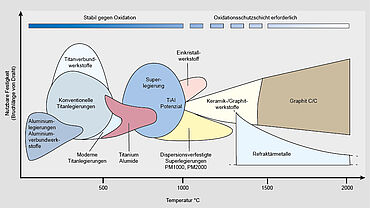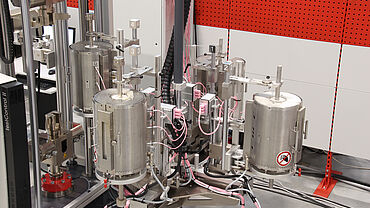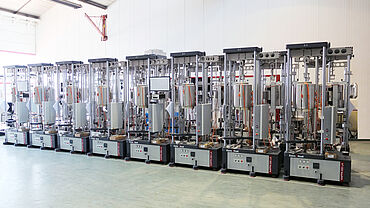Development of Innovative High-Temperature Materials – Materials Testing at up to 2,000°C
Metallic and ceramic high temperature materials present a fundamental field of research within energy technology and mobility. The overall efficiency of power plant or aircraft turbines often depends on their performance. The materials must withstand high mechanical and corrosive loading at high temperatures of over 1000 °C. At the same time, the density should not get too high, especially during turbine construction, since the loading in the material depends on its own mass for rotating parts. ZwickRoell offers various testing systems for materials testing at up to 2,000°C.
In addition to placing a greater focus on regenerative energy sources, in order for energy conversion to be a success, it is essential to optimize conventional power plants by equipping them with the latest technology and also to implement innovative energy policies for automotive technology. For energy conversion systems in single cycle operation (e.g., steam or gas turbine power plants and combustion engines) as well as in multi-cycle systems (e.g., gas and steam turbine combined power plants), higher thermal efficiencies and thereby lower CO2 emissions can only be achieved by increasing the process temperatures and pressures. This also applies to aircraft turbines.
For technical implementation, the potential of existing metallic and ceramic materials, such as for compressors, turbines, combustion chambers, and boilers must be further developed on a continuous basis. Metallic materials are increasingly subject to corrosive loading at elevated temperatures due to the atmosphere in which they are used. Therefore, it is vital that the materials are protected from corrosion. One way to protect them is by forming a passivation layer through the material itself. For the high temperature range, the oxides from chromium (Cr2O3, up to approximately 900°C), aluminum (Al2O3, up to approximately 1,500°C) and silicon (SiO2, up to approximately 1,800°C) are best suited to be used as protective coatings.
For optimized material development, it is extremely important that there is a sound understanding of the correlations between chemical compounding, microstructures, and mechanical properties / long-term stability. To ensure ideal utilization and thus economical use of these normally expensive high-performance materials, on the one hand, reliable material characteristics under practical loading (e.g., tensile loading, fracture mechanical behavior, creep, and fatigue in application relevant environmental conditions as well as thermo-mechanical fatigue) must be determined. On the other hand, models for durability forecasting under complex loading must be prepared in order to avoid overdimensioning and at the same time achieve the best possible reliability in long-term operation.
In addition to improved base materials, metallic oxide protective coatings and thermal barrier coatings in conjunction with suitable cooling methods can contribute considerably to increasing the process temperature. When developing new materials it is vital to ensure that the compiled results are not only technically feasible, but are also economically beneficial and reliable under long-term operation.
High-temperature tests for the determination of thermal-mechanical properties
High-temperature tests (e.g. tensile and flexure tests) are used to determine the thermal-elastic behavior, heat resistance and re-crystallization temperature of materials. It is common practice to install the high-temperature unit (up to 2,000°C) directly in the materials testing machine. This arrangement allows tensile tests to be performed at both room temperature to ISO 6892-1 or ASTM E8 and at elevated temperatures to ISO 6892-2 or ASTM E21. During testing at room temperature, components such as the high-temperature furnace (1- or 3-zone furnaces), and high-temperature extensometer are simply swiveled out of the test area. Using a centrally divided hinged furnace enables the pull-rods in use to be inserted and withdrawn easily via a quick-change system. These ZwickRoell solutions feature optimal coordination of furnaces including temperature controllers, the correct specimen grips for tensile and flexure tests, and the appropriate extensometer. With the videoXtens (up to 1,200°C) video extensometer and the laserXtens (up to 1,800°C) based on the laser speckle principle, ZwickRoell offers two non-contact measuring solutions that are ideally suited for high temperature tensile testing. These systems have clear advantages particularly when used with sensitive specimens and at high temperatures in the air and in a vacuum.
The combination of the volumes in the furnace, the temperature tolerances and hold times specified in the standard, together with the heating and cooling times, basically predetermine the duration of tests. To reduce specimen throughput time, systems with up to six furnaces are available.
Thermo-mechanical fatigue (TMF)
Aside from reliability during long-term operation, the power plant and aircraft turbines must show sufficient resistance against short-term load changes and start-stop processes. Thermo-mechanical fatigue (TMF) is the simulation of this mechanical load as a result of the thermal expansion of the material. During startup, the temperature of all components rises from room temperature to operating temperature, which is accompanied by an expansion of the material. This expansion creates a stress in the material, which must be determined with accuracy to prevent component damage. For composite components such as turbine blades with ceramic thermal barrier coatings, the thermal mismatch between metallic and ceramic components leads to another loading component that must be considered during design. Also, adhesive oxide coatings influence the fatigue life during operation.
Thermo-mechanical fatigue involves heating a specimen cyclically; the materials testing machine superimposes a mechanical strain in the same or inverse phase. For these TMF tests, induction heating systems are typically used since they can display very quick and controlled heating and cooling phases.
Determination of creep behavior
In addition to static-mechanical properties, the time-dependent deformation, damage, and failure behavior is extremely important for developing high temperature materials. Not only temperature and mechanical loading play a role in practical application, but also the surrounding atmospheres in which the materials will be used play a role due to possible superimposition from mechanical damage and corrosion. Therefore, creep tests and stress relaxation tests are performed in the air as well as under simulated operating environments.
The Kappa 50 SS-CF creep testing machine with the videoXtens non-contact extensometer is ideal for these test methods. Along with the above-mentioned test methods, creep fatigue tests as well as tests for investigating the tear growth and SSRT (Slow Strain Rate Tests) can be performed in a temperature range of up to 1,100°C. It is not uncommon for a single test to take well beyond 10,000 hours before any valid conclusions about long-term behavior can be reached.


